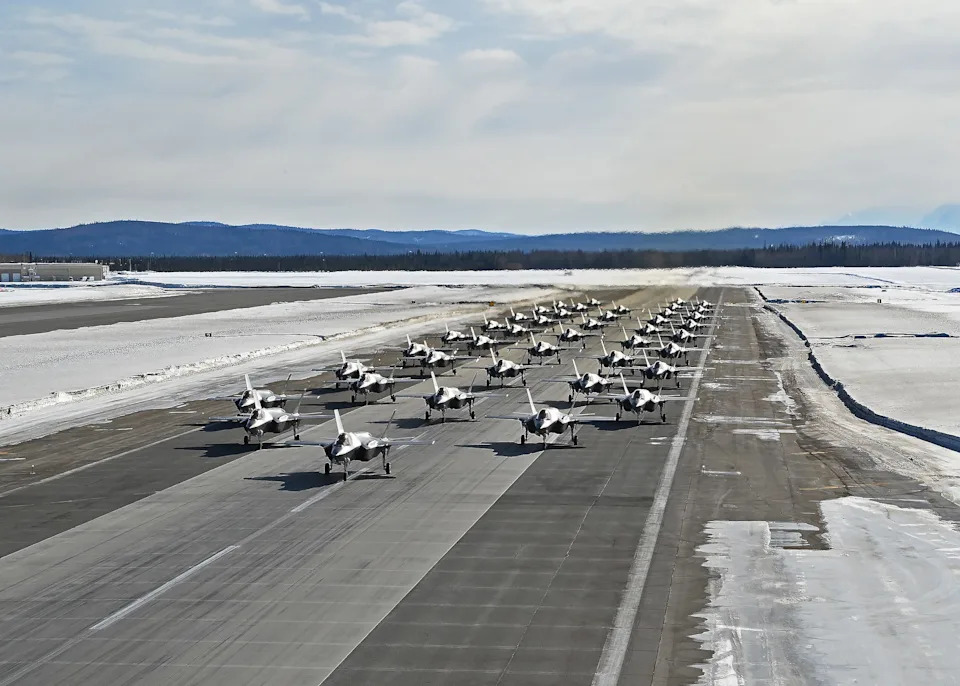An F-35 fell from the air and exploded in a fireball in Alaska earlier this year.
An investigation found that ice made automated systems think the jet was on the ground.
The "uncontrollable" jet was destroyed, but the pilot ejected safely.
An Air Force investigation found that ice buildup in an F-35's landing gear tricked the jet into thinking it was on the ground — a failure that sent the fighter crashing in Alaska and erupting in flames.
Footage of the January incident at Alaska's Eielson Air Force base showed the jet tumbling downwards in the sky and hitting the ground, causing a fireball.
A new report released this week by the Air Force Aircraft Accident Investigation Board found that the ice in the landing gear caused the fighter's automatic systems to wrongly assume that it had landed even though it was still in the air, making the aircraft "uncontrollable."
The pilot was able to eject safely before the impact on January 28 and suffered only minor, non-life-threatening injuries, the report said. But the aircraft was destroyed on impact, with the total loss valued at $196.5 million.
Investigators found the crash traced back to contaminated hydraulic fluid. The 355th Fighter Generation Squadron hadn't followed the rules for handling fluid barrels, and the jet was refueled from one that contained a large amount of water. That water froze after takeoff, stopping the front landing gear from working properly. Instead of retracting, the gear jammed, tilting the aircraft to the left and setting off the chain of failures that caused the crash.
The pilot went through initial emergency checklists and then had a call with engineers at Lockheed Martin, the jet's manufacturer, and the on-duty supervisor of flying, to come up with a plan.
The pilot flew for around 50 minutes while they tried to find a solution on the call and then did two touch-and-go landings to try to center the nose landing gear. Both failed to recenter it.
The report said ice inside the landing gear prevented first the right strut, then the left, from fully extending after takeoff.
After a second touch-and-go landing, the jet's sensors gave a "Weight on Wheels" signal that told the aircraft it was on the ground, switching it into an automated "on ground" flight mode.
"But because it was actually airborne," the report said, "the aircraft was uncontrollable."

"The pilot successfully ejected and emergency responders were at the scene within a minute," it said.
After the pilot ejected, the F-35 flew upwards, reaching 2,665 feet above ground level before it stalled and fell to the ground.
Ultimately, the board concluded that "the cause of the mishap was hydraulic fluid contaminated by water that froze" in the nose landing gear and the main landing gear struts.
But it pointed to other factors, too.
The Air Force Aircraft Accident Investigation Board president also found that "by a preponderance of the evidence, that crew decision making including those on the in-flight conference call, lack of oversight for the Hazardous Materials program, and lack of adherence to maintenance procedures for hydraulic servicing were substantially contributing factors."
The report said those on the call could have looked at recent Lockheed Martin information that said "Weight on Wheels" sensor issues "could lead to aircraft controllability issues."
It said that had they "considered this potential outcome, they likely would have advised a planned full stop landing or a controlled ejection instead of a second touch-and-go."
The investigation further added said that procedures for storing the hydraulic fluid, a hazardous material, may also not have been followed and that "the barrel used to service the mishap aircraft was contaminated with significant amounts of water." But due to a lack of documentation, the board president said that he "could not identify when the water was introduced into the landing gear struts."
The fifth-generation F-35, a multi-role fighter operated by 19 countries, has been involved in around a dozen major crashes since its first in 2018. The most recent incident occurred in July, with one of the jets crashing in a California field. The incident rate overall remains relatively low though.
The expensive fighter program has faced criticisms throughout its development, especially as setbacks and technical challenges resulted in delays and ballooning costs. Concerns remain over the delays in the latest upgrades, and some critics have proposed replacing crewed fighters with drones. For now, though, this fighter remains a key element of US and allied airpower.
Read the original article on Business Insider








Comments